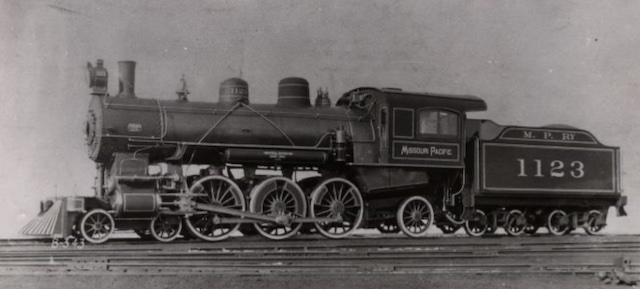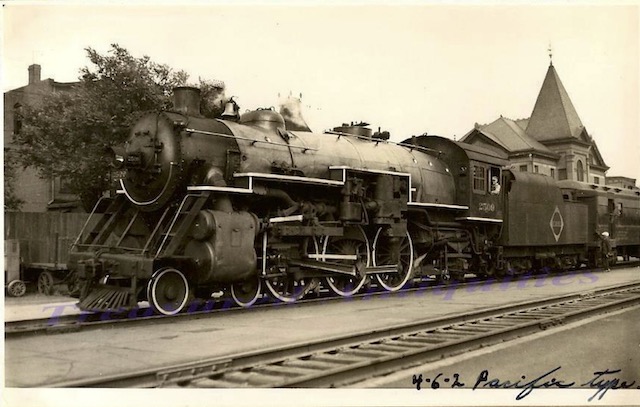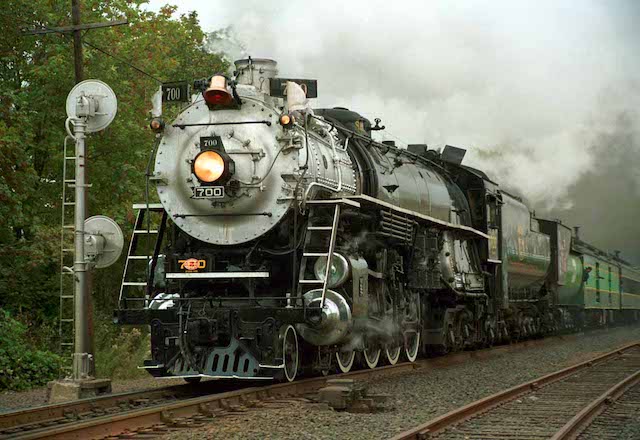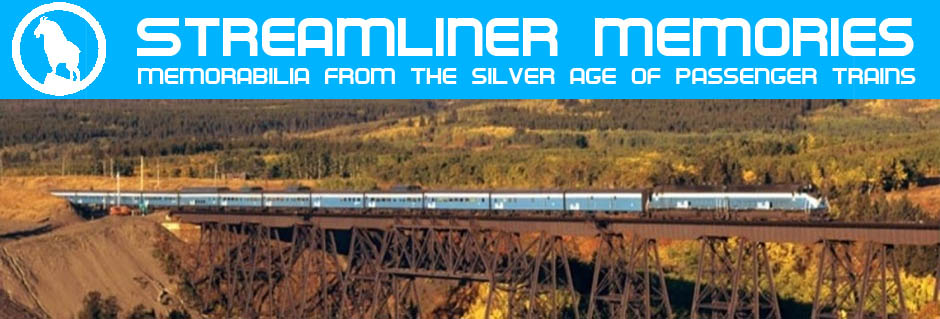In 1901, the American Locomotive Company (ALCO) was created by merging eight locomotive manufacturers to better compete with Baldwin, the nation’s largest locomotive maker. The next year, ALCO delivered to the Missouri Pacific the first 4-6-2 built for an American railroad. Baldwin had already built some 4-6-2s for New Zealand railways the year before, and while most sources say this wheel arrangement was named “Pacific” after the Missouri Pacific, the Smithsonian’s William Withuhn says it was “in recognition of the New Zealand connection.”

In 1902, Alco made nine 4-6-2 locomotives for the Missouri Pacific, the first ever built for an American railroad, and this is the last of the nine. It had 69″ drivers and produced 25,623 pounds of tractive effort. Click image for a larger view. Photo from the Missouri State Archives.
The MP locomotive built by Alco produced more than 25,000 pounds of tractive effort, more than any American and all but a few Atlantics built up to that time. In addition to a larger firebox carried by the two-wheel trailing truck, the Pacific locomotive was aided by the longer boiler atop the six driving wheels. A longer boiler meant more evaporative heating area, allowing the locomotive to sustain more steam production.
One way to better utilize steam from a boiler was through compound cylinders, which meant that one or more cylinders were smaller and used high-pressure steam while another one or two were larger and were powered by the lower-pressure exhaust steam from the high-pressure cylinders. Alco and Baldwin promoted compound locomotives after 1900, but the railroads quickly decided that they were too difficult to maintain and most were “simpled” by eliminating the low-pressure cylinders or replacing them with smaller high-pressure ones. In 1911, Santa Fe built ten compound locomotives that performed so poorly that the railroad ended up firing or demoting most of its top mechanical engineers, an action that dampened experimentation with compound engines throughout the industry.
A more successful way of increasing steam production was superheaters, which routed steam through the boiler tubes a second and third time (and sometimes a fourth and fifth time) to increase the temperature of the steam. Superheating increased locomotive efficiencies by 25 to 30 percent, and unlike compound cylinders they did so with no moving parts or other complexities. Superheated 4-6-2 locomotives commonly had tractive efforts of 40,000 pounds.
 Alco built this superheated 4-6-2 locomotive in 1910 and, after demonstrating its capabilities to various railroads, sold it to the Erie. This locomotive was highly influential as very few locomotives had been built with superheaters before it and very few were built without superheaters after it. Click image to download a PDF of this postcard.
Alco built this superheated 4-6-2 locomotive in 1910 and, after demonstrating its capabilities to various railroads, sold it to the Erie. This locomotive was highly influential as very few locomotives had been built with superheaters before it and very few were built without superheaters after it. Click image to download a PDF of this postcard.
Some European railroads experimented with superheaters as early as 1899. A few U.S. railroads tried them, but by the end of 1906 only 15 U.S. locomotives had superheaters. In 1910, to commemorate its 50,000th locomotive, Alco built a demonstrator 4-6-2. Built with superheaters, it was the most powerful Pacific-type locomotive built up to that time, producing more than 40,000 pounds of tractive effort. Nearly all steam locomotives built in the U.S. after 1910 included superheaters, and many older locomotives were retrofitted with them, suggesting locomotive 50000 was highly influential. Missouri Pacific added superheaters to its original 4-6-2s in 1916 which allowed for an increase in cylinder size, boosting power by more than 10 percent.
In 1911, Chicago & North Western compared two models of 4-6-2 locomotives that were built to mostly similar specifications but one had superheaters and the other did not. The one with superheaters also had slightly larger cylinders but operated at a lower boiler pressure so that the tractive effort of the superheated locomotives was about 9 percent greater than the others.
Not only did the superheated locomotives save water and fuel, the railroad reported (see p. 56), but they were able to run faster. For example, a train led by a superheated locomotive could leave Madison 35 minutes late and arrive in Elroy, 74 miles away, on time. Though the schedule allowed two hours between the two cities, the non-superheated locomotives were never able to make up any time on this segment, suggesting their top speed was less than 40 mph while the superheated locomotives could exceed 52 mph.
Superheated 4-6-2s were to early 20th century passenger trains what 4-4-0s were to mid-19th century passenger trains. With 6,800 built, nearly all of them made or retrofitted with superheaters, the 4-6-2 is the second-most-common predominately passenger locomotive ever built in this country.
At least as important as the superheater was the mechanical stoker. According to Alfred Bruce, this was “by far the greatest single mechanical contribution made to the coal burning steam locomotive.” A typical fireman could shovel only about 5,000 pounds of coal per hour into a firebox, which limited the power of a locomotive just as much as a small firebox. Mechanical stokers allowed builders to make locomotives that were two to four times more powerful than hand-stoked engines.
The use of mechanical stokers led to the production of much larger locomotives. Alco built one of the first, a 4-8-2, in 1911, for the Chesapeake & Ohio, which called it a Mountain locomotive because it was used to cross the Appalachian Mountains. With more than 58,000 pounds of tractive effort, it was more than twice the weight and twice the power of Missouri Pacific’s 4-6-2 locomotive from just nine years before.
In 1925, Lima Locomotive Works reversed this pattern by building a 2-8-4 locomotive, the first to use a four-wheel trailing truck. This allowed for an even larger firebox. When combined with superheaters and a steam-powered booster for the lead truck of the tender, Lima called these locomotives “Super Power.” The locomotive had about the same tractive effort at low speeds as a recent 2-8-2. Yet it produced greater horsepower at speeds of 30 to 40 mph, allowing it to pull more freight faster, which was becoming important as railroads faced increased competition from trucks.
Still, “super power” was a marketing term. Compared with 19th-century locomotives, 20th century engines with larger fireboxes supported by a trailing truck, superheaters, and mechanical stokers were all superpowered.
In general, locomotives with two-wheel leading trucks were used for freight while four-wheel leading trucks were needed for higher speed operations typical of passenger trains. The next natural step for passenger locomotives would be to add a four-wheel trailing truck to a 4-8-2. Alco would make the first 4-8-4 locomotive for Northern Pacific in 1926, leading to this type being commonly called a Northern.
As of 1925, NP had not purchased any 4-8-2 locomotives and was still relying on 4-6-2s to pull its passenger trains. These weren’t powerful enough to haul the North Coast Limited and other trains over the Rockies and had to be double headed, so NP was contemplating buying 4-8-2s.
At the same time, Montana coal miners went on strike, cutting NP off from its source of bituminous coal and forcing it to rely on lower-quality coal. To produce the same amount of steam with poor fuel, its locomotives needed extra-large fireboxes, and so it ordered the first 4-8-4s from Alco.
 The SP&S 700, the last surviving Northern Pacific-designed 4-8-4 locomotive.
The SP&S 700, the last surviving Northern Pacific-designed 4-8-4 locomotive.
Including the tender, NP’s first Northern weighed 731,000 pounds, had 6,876 square feet of heating area, and produced more than 57,500 pounds of tractive effort. Later Northerns commonly produced 65,000 to 75,000 pounds of tractive effort and could provide all the steam needed for high-speed operations by boiling as many as 4 gallons of water per second.
In just 25 years, locomotives had virtually quadrupled in size and power. NP’s Northerns proved to be successful enough that many other railroads, including Burlington, Great Northern, New York Central, Santa Fe, Southern Pacific, and Union Pacific, ordered many for their passenger trains even though they used higher quality coal or oil as fuel.
Union Pacific used 4-6-6-4 Challenger locomotives to haul some of its passenger trains and Pennsylvania built a variation of the Northern that had a 4-4-4-4 wheel arrangement. But for most other major U.S. railroads, the 4-8-4 Northern was the apex of steam passenger locomotion.
The reverence steam enthusiasts have for the 4-8-4 shows in the numbers of locomotives that have been preserved and restored. About 2,200 4-8-2 locomotives were built in the U.S. of which just 17 were preserved and only one is operable. Only about 1,100 4-8-4s were built for U.S. railroads, yet more than 60 4-8-4s were saved from the scrapper, with around a dozen in operating condition.
Important U.S. Locomotive Types
| Type | Number Built | First Built | Railroad |
|---|---|---|---|
| 4–4–0 | >25,000 | 1837 | Beaver Meadow |
| 4–6–0 | >17,000 | 1847 | Reading |
| 2–8–0 | >33,000 | 1866 | Lehigh Valley |
| 4–4–2 | 2,000 | 1894 | Atlantic Coast Line |
| 2–6–2 | 1,700 | 1898 | McCloud River |
| 4–6–2 | 6,800 | 1902 | Missouri Pacific |
| 2–10–2 | 2,200 | 1902 | Santa Fe |
| 2–8–2 | >14,000 | 1903 | Lehigh Valley |
| 2–8–8–2 | 700 | 1909 | Southern Pacific |
| 4–8–2 | 2,200 | 1911 | Chesapeake & Ohio |
| 2–8–4 | 750 | 1925 | Boston & Albany |
| 4-8-4 | 1,100 | 1926 | Northern Pacific |
| 4–6–4 | 500 | 1927 | New York Central |
| 2–8–8–4 | 200 | 1928 | Northern Pacific |
| 4–6–6–4 | 200 | 1936 | Union Pacific |
| 4–8–8–4 | 25 | 1941 | Union Pacific |
This list (which is the same as yesterday’s) does not include all locomotive types, but only the most common types built for passenger service and a few common types for freight service. Sources: Alfred Bruce, The Steam Locomotive in America and SteamLocomotive.com.
Without the development of locomotives with larger fireboxes supported by trailing trucks and supplemented by superheaters, the all-steel passenger car revolution would not have been feasible. The all-steel revolution also required heavier rail to support steel cars and bigger locomotives and sometimes needed stronger bridges, but these were financial, not technical issues. Solving the technical issues enabling superpowered locomotives made possible longer and heavier passenger trains including such famous names as the 20th Century, Broadway, Overland, and California limiteds.
Over the next several months, I will look at various corridors to see how competition, all-steel trains, and superpowered locomotives changed travel in those corridors. By the time you read this, I’ve already written posts for the New York-Chicago, Chicago-Los Angeles, Chicago-Seattle, Chicago-Denver, and Chicago-Twin Cities corridors.
My hypothesis is that these innovations led to faster, more comfortable limiteds that significantly boosted rail travel during what has been called the Golden Age of passenger trains. Spoiler alert: this hypothesis turns out to be wrong. To find out why, keep reading this blog.
Information in this post came from various sources including Alfred Bruce’s The Steam Locomotive in America and William Withuhn’s American Steam Locomotives.
